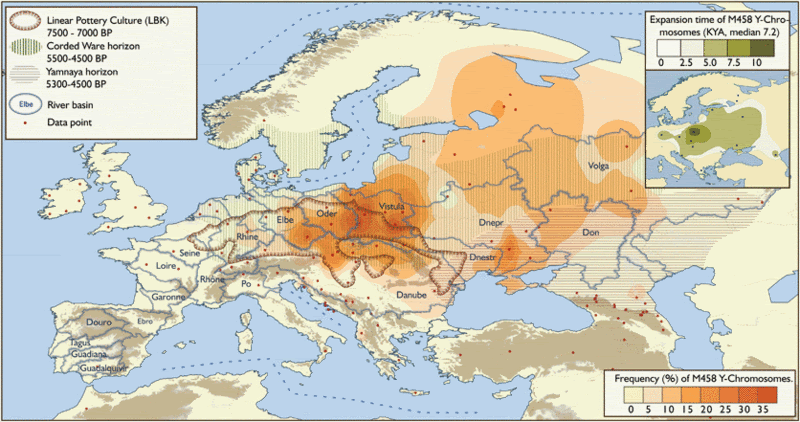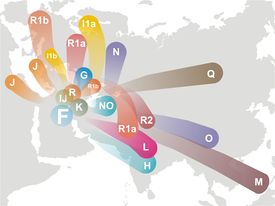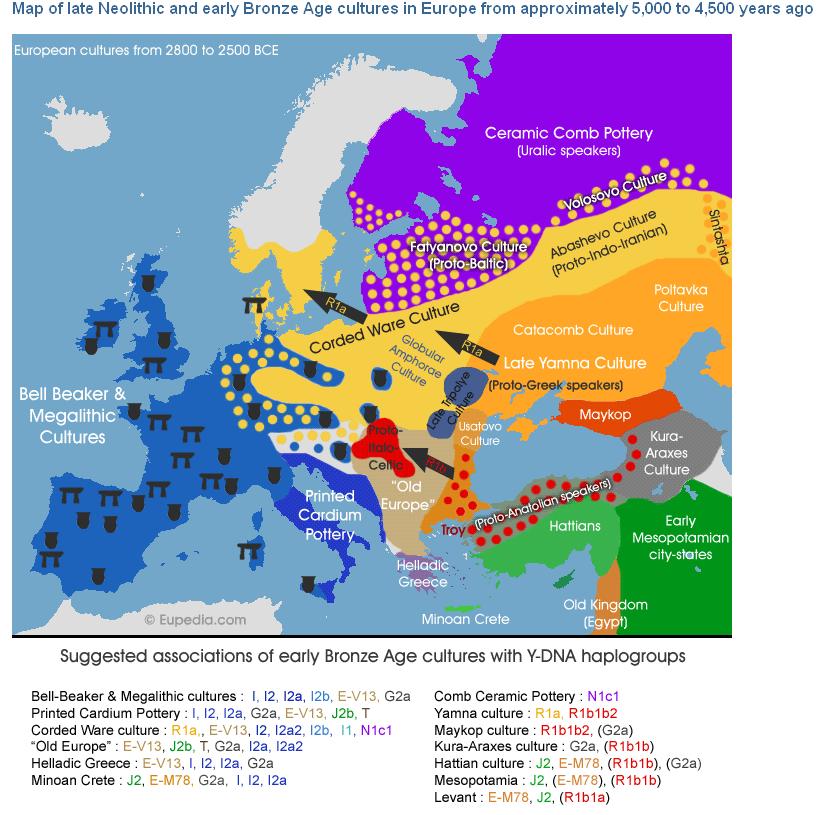[Niniejszym inaugurujemy zapowiedziane translacje naszych artykułów na język angielski. Jak sądzę w związku z ich publikacją częstotliwość pojawiania się kolejnych artykułów na stronie wzrośnie, a okres ich obecności na Ekranie Głównym zmniejszy się prawdopodobnie do 2 dni. Artykuły w języku angielskim będą „podpinane” na stałe na Czarnym Pasku po prawej pod artykułami w języku polskim
CB]
© by Winicjusz Kossakowski
© translation by Katarzyna Goliszek
An article with this title was published by Faral. Source: Nowy Ekran. The author notes that the data to work out come from ”Distribution of European Y – chromosome DNA (Y-DNA) haplogroups by country in percentage.
The author along with scientists of Germanic origins are searching for the haplogroup of Y chromosome for peoples regarded as Germanic.
Below there are some significant quotations from Faral’s work.
HAPLOGROUP R1a
Let us learn about the haplogroups starting from undoubtedly the most important one for us since over 50% of inhabitants of our country (Poland) as well as inhabitants of neighbouring countries own this haplogroup. The mutation occurred about 21.000 years ago on the territories of southern Russia. As far as our territories are concerned, this haplogroup is represented by the culture of lace pottery from 3300 – 2500 BC. Expansion of this haplogroup is related to domestication of the horse on the steppes of Eurasia. Those people were so expansionist that today they make up over 20% of population of such distant areas as the western part of Scandinavia or Iceland. It is worth mentioning that 80% of population belonging to the highest castes in India are owners of this haplogroup.
HAPLOGROUP R1b
To talk about this group, it is significant to mention the history of Europe from the period of AD
V – VIII. Until present that period in history has been described as expansion of Germanic tribes who pushed off the Celts onto territories of present Britain, Wales, Scotland. Nevertheless, let us compare these pieces of information with the frequency of the presence of the haplogroup R1b on those territories. Insofar as in the countries considered Germanic now (Germany, Austria, Switzerland), the R1b haplogroup is present at 40 – 50% of people, insomuch in Ireland, Scotland, Wales, western France where we talk about descendants of the Celts, this group is present at about 80% of people. This group is evidently associated with the Celts. What is noticeable, this haplogroup is younger than R1a for it appeared about 20.000 years ago in the areas of the the Caspian Sea and Central Asia.
HAPLOGROUP I1
Some people want to define the haplogroup I1 as pre – Germanic. The I1 haplogroup is the oldest one in Europe and it was very likely to occur at the vast majority of people from Cro – Mangan. Similarly, the oldest megalithic buildings were created by people with this haplogroup. Later on, between 10.000 and 5.000 years ago in Jutland and Scandinavia the I1 haplogroup dissected from it. At present, this group is relatively small. Practically, 30 – 40% of people in central Scandinavia and Iceland have this haplogroup. In the countries described by history as Germanic the presence of I1 is said to be about 10 – 20%. Beyond the shadow of a doubt, it is a local, Scandinavian and an old mutation of a little importance in today’s Europe and certainly they were not the Germanic peoples who could invade such advanced civilisations as the Roman Empire.
 Haplogroup R1a1g7 – archeologic culture
Haplogroup R1a1g7 – archeologic culture
SO WHERE ARE ”THESE” GERMANIC TRIBES THEN?
The way of reasoning and gained values presented above would clearly indicate that there were not migrations of Germanic tribes to Europe. The peoples that have been usually described by us as the Germanic tribes were intermingled peoples of Scandinavia I1, Slavic peoples of R1a1 and Celtic of R1b who were joined by common interests, community of dwelt territories, and, of course, a common leader who pressured them to advance to Rome.
However, let us consider opinions of the supporters of the thesis stating that Germanic tribes originate from descendants of the old European haplogroup I1 whose bearers were replaced by R1b. What arguments do they have?
Firstly – polygamy.
A male of a higher social status had the possibility to conceive children with a greater number of women. The Indoeuropeans who brought to Europe both the domesticated horse and bronze, had to gain a higher material status over the native tribes of I1 group, which assured them that they could have more children. Secondly, as a result of fights men of local tribes died (worse armoured and less combative). Consequently, considering that there were usually more men than women in the group of invaders, this caused situations in which after invasions more newcomers’ children were born than children of the natives who survived. Thirdly, they point out that R1b bearers tend to have predisposition to conceive boys in comparison with I1. Successful spreading of the haplogroup of chromosome Y is determined by the sperm efficiency in relation to the carrying X chromosome of males with the I1 haplogroup, so the probability of conceiving a male descendant would be smaller than in the case of R1b carriers.
This standpoint supporting Scandinavia as a birthplace of Germanic nations demonstrates that I1 both regarding its possibility of passing genes on as well as considering its civilisation was recessive. As a consequence, people bearing this chromosome could not be territorially expansionary, which peoples called Germanic showed in history.
Yet, undoubtedly, the success of so called Germanic nations in terms of genetics is relatively short. All in all, a period of over 1000 years is not much. Taking that into consideration, nations regarded as Germanic in history were tribes carrying mutations of I1, R1a, R1b joined by their common interests, that is Scandinavians, Slavs and Celts with their present share in the population (20% – 20% – 40%).
WHO ARE THE POLISH?
In 2009 next mutations were found in the R1a1 haplogroup specifying an interesting R1a1a7 haplogroup for the Polish. Its age was evaluated at 10.700 years. Taking into consideration dispersion in populations, scientists stated that the most representatives of this group live in central and then in southern Poland. Hence, it is assumed that it was in Poland that this mutation occurred 10.700 years ago. Bearers of this mutation have been living in territories of present Poland since that time. From Poland, this mutation spread outside, among others, to the Balkans, Greece, Crete, where it is present at 2 – 3% of population. The carried out anthropological research of the cultures inhabiting Poland seems to prove this.
UGRO-FINNS
The N1c1 haplogroup appeared 12.000 years ago in Siberia. It was brought to Europe by a steppe people. It is the most common in Finland 58%, in Estonia 34% and Hungary 1%. Contemporary Hungarians have the prevalent group of R1a, from 32% to 60%, so it means the Slavic mutation. One percent of Magyars dominated over Slavic people and imposed its language on them.
Basing on this contrariness, I would search for an answer to the question in the title of this article: ”What happened with Germanic peoples?”
How come the Germanic language is in central Europe?
Well, at this point we have to forget genetics. Tadeusz Miller in his project „3 tysiące lat państwa polskiego” (”3 Thousand Years of Polish State”) placed a map of Germanic tribes’ migration with a depiction.
According to a German scientist Fressel, Germanic tribes initially inhabited Asia near Samarkand, the place from which going through Caspian steppes, the Eastern European Upland and Valday Hills they reached the Baltic. Further on, from the shores of the Gulf of Finland they got across ice to he Aland Islands and then through the Gulf of Bothnia – to the Scandinavian Peninsula, in the areas of Sigtun, Uppsala and Birka which became their new settlement place. In the VI th century BC, they tried to settle in the northern part of the Venetian Peninsula, called the Jutland Peninsula today. There, joining local Slavic tribes they began expeditions to Western Europe. They were appreciated for their war and organisational experience. Slavic dukes and legions of Rome made use of their help. At the time of the disintegration of the Roman Empire there was a revolt in the army. Some commanders took out small areas from the Empire and created their own duchy. By contrast, others, militarily stronger, took them under their own command. All in all, they together moved on to loot Rome. (”Empires and barbarians, migrations and birth of Europe” – Peter Heather).
A newly created religion, based on commonly practised Mithraism (a faction of Zarathustra religion) was to, in accordance with the Edict of Milan from AD 313, consolidate nations of the Empire in one monolith with its basic law giving power to the Caesar: ”Power comes from God”.
The Caesar made a basic mistake taking on obliging Judeans as priests in the new church. That paid back soon and the empire ceased to exist. Christians helped the rebelled mercenary army of so called brothers and friends (germanus) during their march on Rome. Rome was taken by the army consisting of 10.000 rebels. The local church hierarchy sniffed out their own interest in it – ”an authority over the whole empire but under a changed name”.
The friends and brothers got back their civil authority but ”divine power” was for Caesars of the German Nation, which took place during hastily made up rituals of coronation and ordination. The Caesar became a military arm of the New Church whose army was aimed at ”conversion” of Slavs.
It is commonly known that Etruscans were the founders of Rome and the first state on the peninsula. Recently read monuments indicate that Etruscans spoke the Slavic language and it was they who regarded Slavs living between the Vistula and the Renn Rivers as brothers and they called them so – ”germanus” in Latin. It stems from logical reasoning. This name appeared in Tacitus’s work, the only copy of which was found in Hersfeld Abbey in Germany, and from which, as some malicious say, ”The ink has not dried yet”. It was taken to Italy in 1456. In the IX th century emperor Porfirogeneta left a message that Germans (brothers) spoke the Slavic Language.
The newly created ethnic mixture of rebelled hired hands consisting of Slavs, Scandinavians and Celtic local people, was given an honourable name ”Brothers” after Slavic allies.
Who were those who brought the language known in our times as German?
I would seek their haplogroups among a few percent of mutations of contemporary Germans. It may be worth looking for a comparative genetic material in the areas of Samarkand as a German scholar Fressler suggests. Contrariness could have repeated as it was in the case of Magyars.
I expect gratefulness for the constructive prompt from contemporary Germans whom nobody wants to call brothers for their excesses in Europe. Or, rather lately – ”ours” want to call them so.
Just one more remark. In monuments discovered in Priwlitz there is a plate made of bronze with an engraved marriage certificate described with the Greek alphabet mixed with the Slavic runes. The content of the inscription is: Berofiej Barbara and an English man Soosnow Bik – Kemekeiaam (page 183 „Polskie runy przemówiły” – ”Polish runes revived”, edition from 2012). The meaning of the Slavic word Bik should be searched for in A. Bruckner’s dictionary of etymology. I associate the verb kemekejam with a klema – a clamp used for binding. Well, it is clamping coming from a clamp. Note that an English man had a Slavic name and surname. The monument comes from the pre – Christian era, the proof of which is an eight armed cross. Did the English happen to be Slavs in those days?
This question is followed by another one. Are other people considered Germanic today Slavic in terms of their origin and language?
By Winicjusz Kossakowski (translation by Katarzyna Goliszek)



